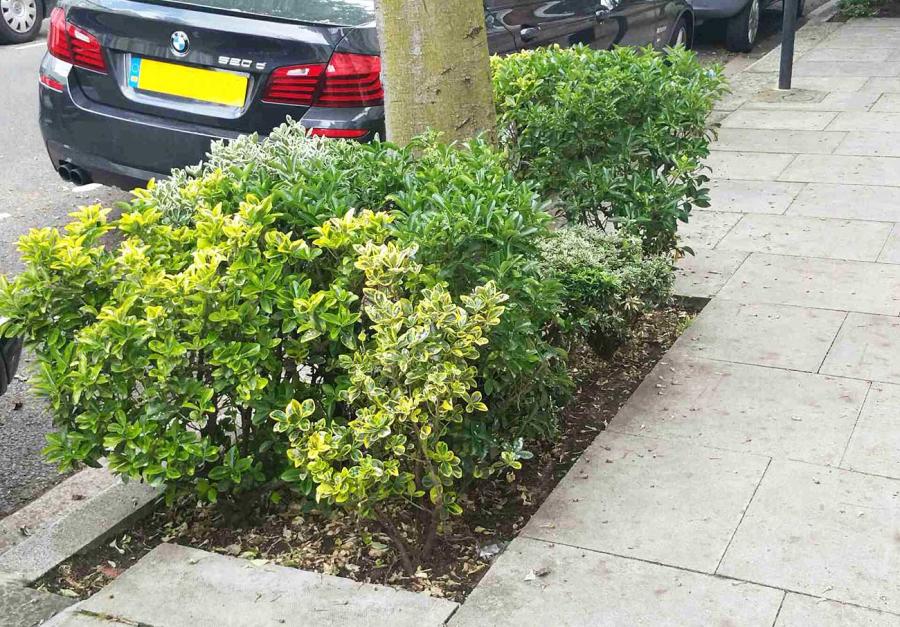
Welcome and thank you for considering doing your bit to make H&F greener by planting a tree base.
We are inviting residents to plant flowers, herbs and shrubs – anything you like really – at the base of trees across the borough as part of our campaign to make streets greener and more pleasant.
Below you'll find a short guide on where and how to get started.
Location
Ideally, we'd like you to plant in the bare patch of dirt you'll often find at the base of the trees that line our streets. However, we don't want to restrict you to just this. If there is a piece of land that is crying out for a spruce up, we won't stop you! However, it does need to be land owned by the council. Some land, such as on housing estates, might require special permissions and we can't condone planting on private land.
If you want to plant a tree base, just let us know the location and once we've confirmed it you can get started. If you want to plant somewhere other than a tree base, please contact us first to check if the location is suitable before you embark on any hard work and to avoid disappointment.
Once you've selected your location, notify us that you plan to plant there by calling 020 8753 1100, or by emailing cleaner.greener@lbhf.gov.uk
This will enable us to notify our contractors and make sure they don't weed your tree base by mistake.
What can I plant?
Whatever you fancy. We just have a few guidelines for safety and to ensure we keep the road looking tidy:
- Avoid planting spiky plants, or plants which can sting, or plants which are toxic
- Avoid planting anything that will grow too large, could block the pavement, or cause a trip hazard for pedestrians. A small shrub should be fine – see examples of planted tree bases on Fabian Road in Fulham
- Please don't plant any invasive species, such as Japanese knotweed, Himalayan balsam, or giant hogweed
- Please avoid using any chemical pesticides to maintain your tree base
- If you plant herbs, we would not recommend eating them if the tree base is by a busy roadside
- Try not to dig too deeply to avoid disturbing or damaging the tree's roots.
Check out our expert Top Tips below for ideas about how to get started, what you could plant and how to attract wildlife.
What happens next?
Once you have planted your tree base, it is up to you to manage and maintain it, to keep it looking nice and tidy. This includes watering, pruning, weeding etc. If you decide you are no longer able to do this, or no longer want to, for whatever reason, ask a neighbour if they will take over. If you have any other issues, or problems, get in touch using the contact details above.
Top Tips
Lucy Hart – Head Gardener, Fulham Palace
I recommend drought-tolerant plants and also to plant young plants in small pots (9cm size) to avoid having to dig oversized holes and risk damaging the tree's roots.
Here are some suggestions:
- Euonymus fortunei 'Emerald Gaiety' – gives good all year round ground cover and copes with shade
- Euonymus fortunei 'Emerald n' Gold' – same as above
- Perennial geraniums such as Geranium endressii, Geranium pratense, 'Mrs Kendall Clark' – benefits from being cut back in July for a second flush and then dies down during winter.
- Sedum spectabile (ice plant) – drought resistant. Will die down in winter
- Rosemary – drought tolerant
- Lavender – drought resistant
- Liriope muscari – evergreen and drought resistant
- Anemanthele lessoniana – lovely evergreen, drought tolerant grass.
Sean Adamson – Chair of The Friends of Marcus Garvey Park
- Make sure you have a water source. Shops or offices nearby might be able to help you out, or you could make a little sign inviting people to water the plants.
- Avoid planting anything that might look nice in a window box, as it may end up in a window box!
- Don't be afraid to re-plant if things get stolen or damaged – tenacity pays off.
- If people tell you that you're wasting your time, it's a sign that they also care about the environment but they're afraid of doing anything. Invite them to help with the watering.
- Most of all, have fun!
Butterfly Conservation – charity promoting wildlife
The tips from Butterfly Conservation will help attract butterflies, moths and other pollinating insects likes bees to your tree base. You can also apply these tips to a garden if you have one:
- Grow lots of nectar-rich flowers between March and November (see RHS list below)
- Choose different plants to attract a variety of species and plant in blocks of the same type
- Prolong flowering life by deadheading flowers and watering well – watering produces more nectar
- Grow caterpillar foodplants for butterflies and moths
- Let an area of grass grow long
- Allow a patch of weeds such as dandelion and birds-foot-trefoil to flourish.
Royal Horticultural Society – charity promoting plants
Here is a list of the top species the RHS recommends planting to attract pollinating insects and boost biodiversity:
Wild plants
- Achillea millefolium (common yarrow)
- Cantaurea scabiosa (greater knapweed)
- Eupatorium cannabinum (hemp agrimony)
- Lonicera periclymenum (common honeysuckle)
- Origanum vulgare (wild marjoram)
- Thymus pulegioides (large thyme)
- Trifolium repens (white clover)
- Verbascum nigrum (dark mullein)
- Viburnum opulus (guelder rose)
Garden plants
- Caryopteris x clandonensis (caryopteris)
- Dianthus barbatus (sweet william)
- Hesperis matronalis (dame's violet)
- Hyssopus officinalis (hyssop)
- Jasminum officinale (common jasmine)
- Lavandula angustifolia (English lavender)
- Lychnis coronaria (rose campion)
- Monarda didyma (bergamot or bee balm)
- Verbena bonariensis (purple top)
- Weigela Florida (weigelia)